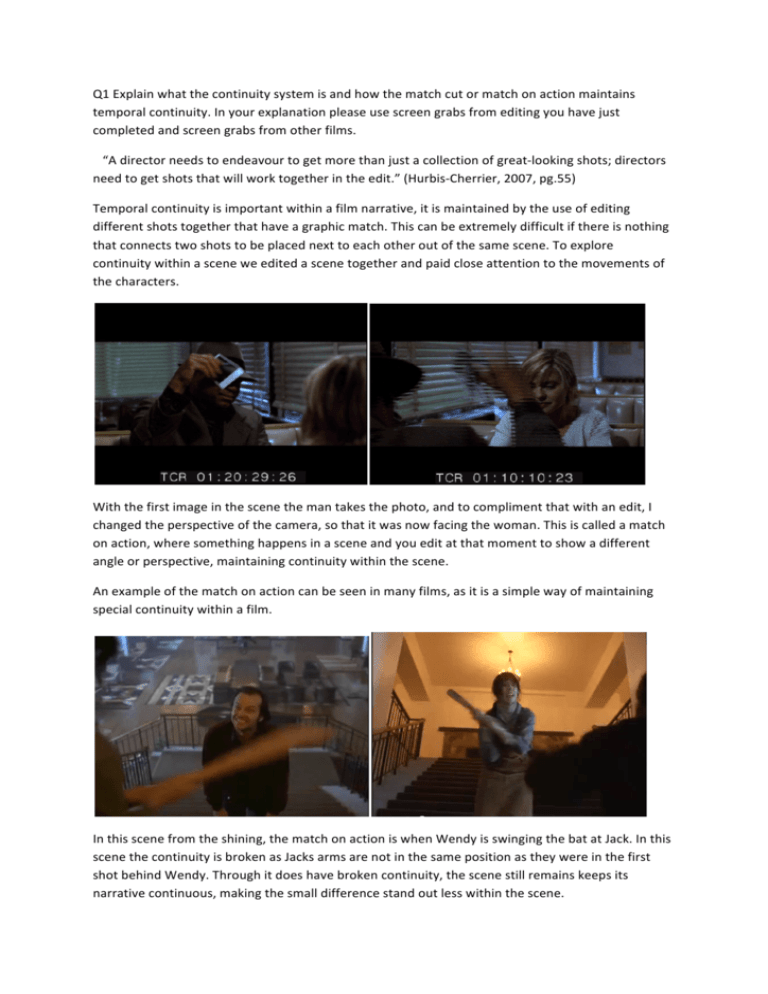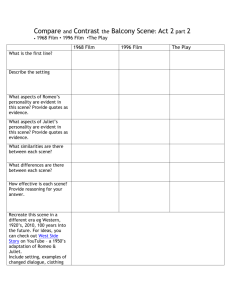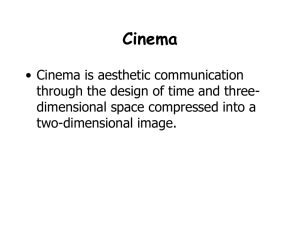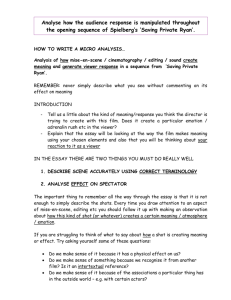Match action - WordPress.com
advertisement

Q1 Explain what the continuity system is and how the match cut or match on action maintains temporal continuity. In your explanation please use screen grabs from editing you have just completed and screen grabs from other films. “A director needs to endeavour to get more than just a collection of great-­‐looking shots; directors need to get shots that will work together in the edit.” (Hurbis-­‐Cherrier, 2007, pg.55) Temporal continuity is important within a film narrative, it is maintained by the use of editing different shots together that have a graphic match. This can be extremely difficult if there is nothing that connects two shots to be placed next to each other out of the same scene. To explore continuity within a scene we edited a scene together and paid close attention to the movements of the characters. With the first image in the scene the man takes the photo, and to compliment that with an edit, I changed the perspective of the camera, so that it was now facing the woman. This is called a match on action, where something happens in a scene and you edit at that moment to show a different angle or perspective, maintaining continuity within the scene. An example of the match on action can be seen in many films, as it is a simple way of maintaining special continuity within a film. In this scene from the shining, the match on action is when Wendy is swinging the bat at Jack. In this scene the continuity is broken as Jacks arms are not in the same position as they were in the first shot behind Wendy. Through it does have broken continuity, the scene still remains keeps its narrative continuous, making the small difference stand out less within the scene. “If we are to cut shot A seamlessly with shot B, then the placement and physical actions of our performer must be consistent.” (Hurbis-­‐Cherrier, 2007, pg.58) It is important to keep the same motions for the actors throughout the shots, as there is then less chance of something going wrong during the edit, but match on action can make it easier to decide when to take an edit, as the motion of the action continues seamlessly from one shot to the next. A match cut is a graphic match of two different scenes where something looks similar, helping the flow of the film progress. An example of this would be the scene in 2001 A Space Odyssey, where the bone is thrown into the air, and is then cut to the ship in space, all the time it keeps its continuity through a graphic matching of images. Q2 Explain what special continuity techniques are (est. Shots, 180degree rule, eye line matches and the triangle system) and how they support the overall continuity system. You should refer again to you editing exercise today and other films you think may support your points Spatial continuity is how the characters in a film interact with the surrounding environment of the mise en scene. “Spatial continuity is a crucial tenet in the continuity system. In order for the viewer to understand the physical space of the scene and the relationships between characters and objects in that space, we need to maintain coherent and consistent spatial orientation.” (Hurbis-­‐Cherrier, 2007, pg.59) The 180 degree rule is a term meaning to film all the action of a scene from one side adjacent to what is going on. This is so we maintain connection between characters and objects in which they interact with. For the 180 degree rule to work, we imagine a line in between the two characters talking, and place the camera on one side, the camera can only then be allowed to film from that side, as it has created a spatial continuity. If you were to film from the other side of the line as well, continuity would not match during editing. Eye line matches are also created when using the 180 degree rule, and if the camera films on the other side as well, then there is a break in what the audience believes they are looking at. The line in the middle of the characters in this sense is called a line of action. “When the line of action is in use, another convention, the triangle system of camera placement, is a shorthand way of describing camera positions on one side of the line.” (Katz, 2007, p130) What Katz means here is that when a camera is placed on one side of the line, there is always two points to the line of action, one person, and the other person, and the camera makes the third point of the triangle. An example of the triangle system and the 180 degree rule being used can be seen in the film The Silence of the Lambs, during the first meeting scene with Hannibal Lector and Clarice Starling. In this scene we can see how the camera position creates a sense of space between the two characters. During the entire scene the camera does not cross the line, although it does have close ups of their faces. We can also see how there is a triangular connection between the two characters and the camera. This is an example that we created from our own editing piece. We incorporated the 180 degree rule into how we edited the piece, making sure to keep the eye line match of the characters, and to not cross the line of action. Katz, Steven D. 1991 –Film Directing Shot by Shot Visualising from Concept to Screen. Michael Wiese Productions Hurbis-­‐Cherrier Mick. 2007 –Voice and Vision: A Creative Approach to Narrative Film and DV Production. Focal Press Productions





